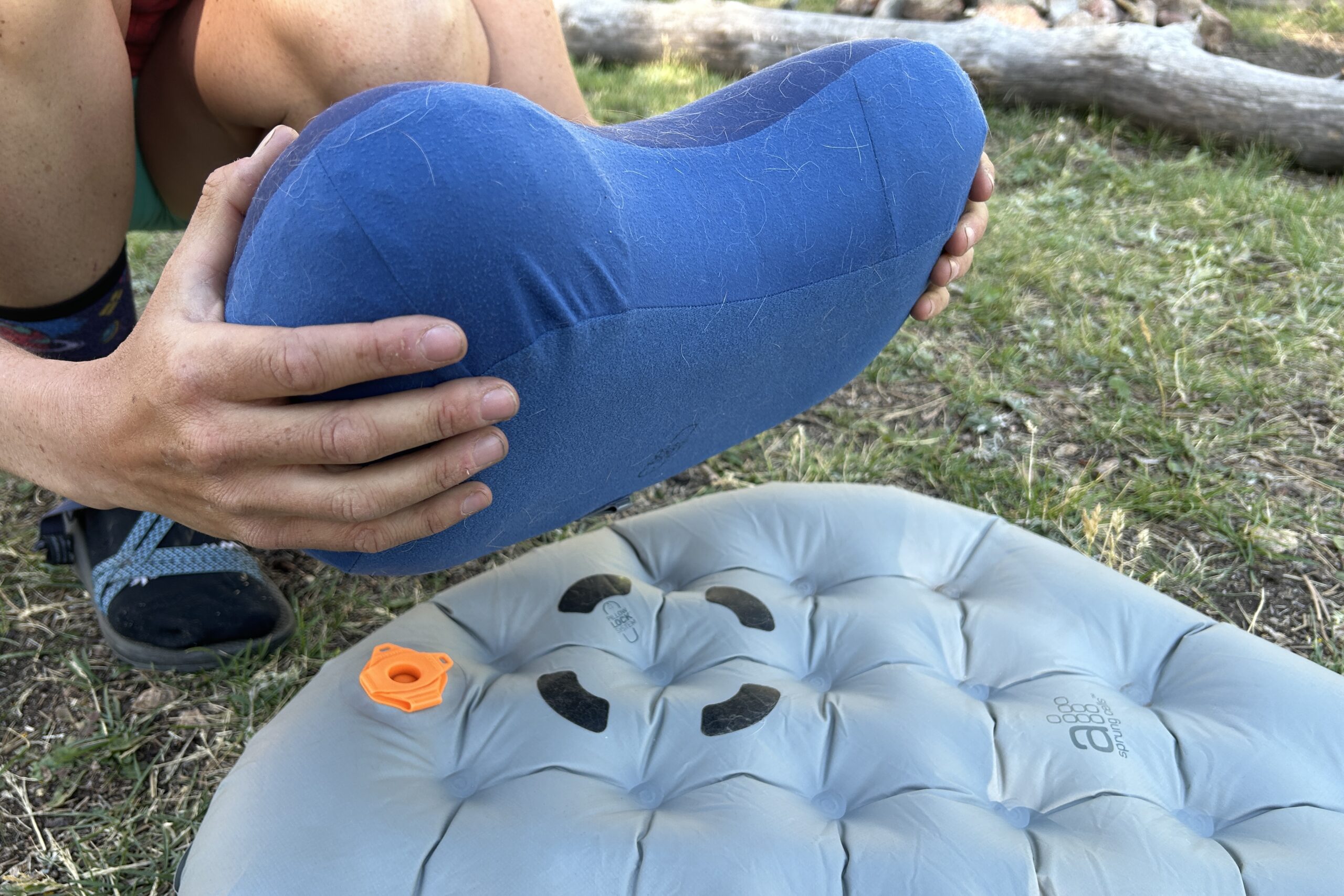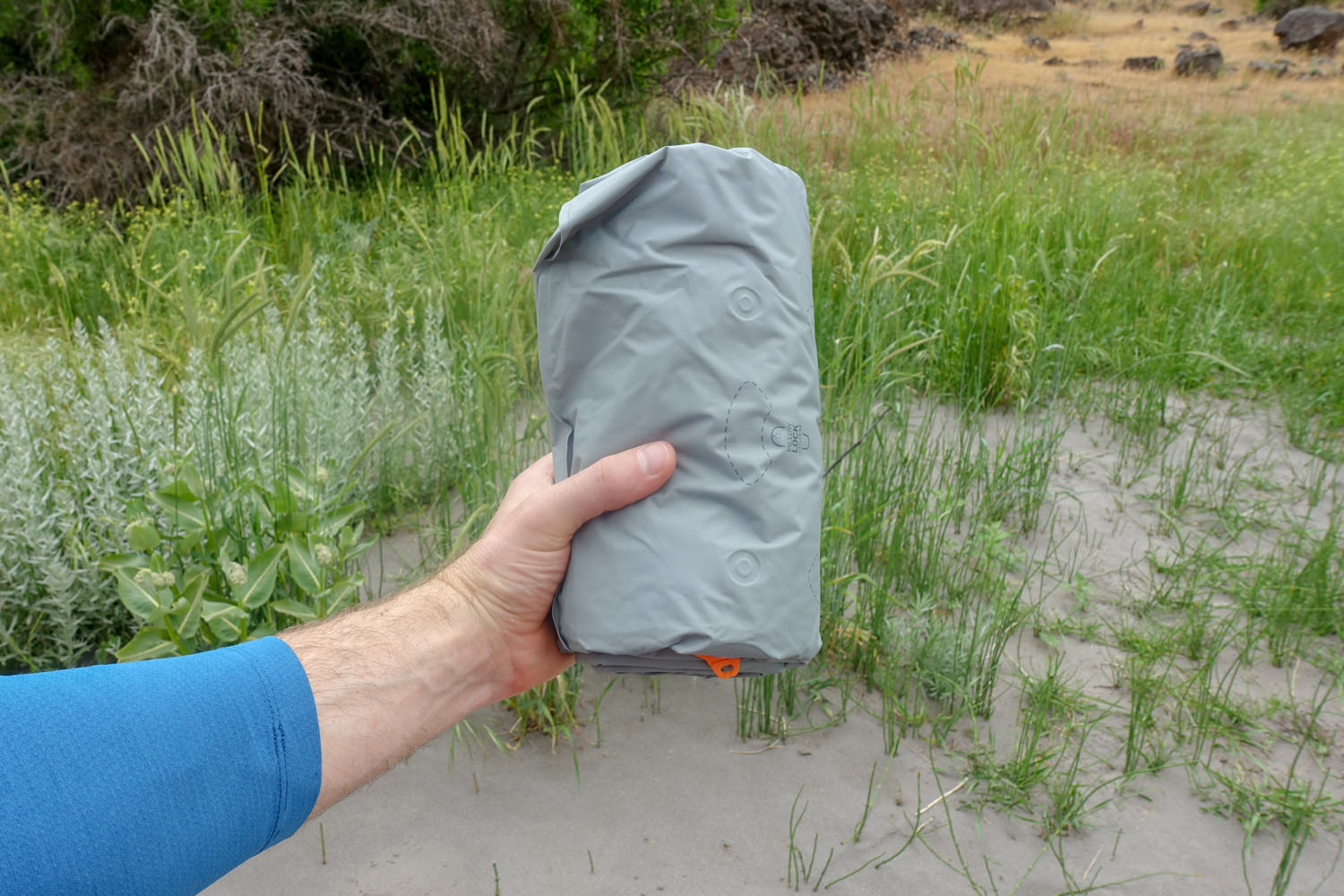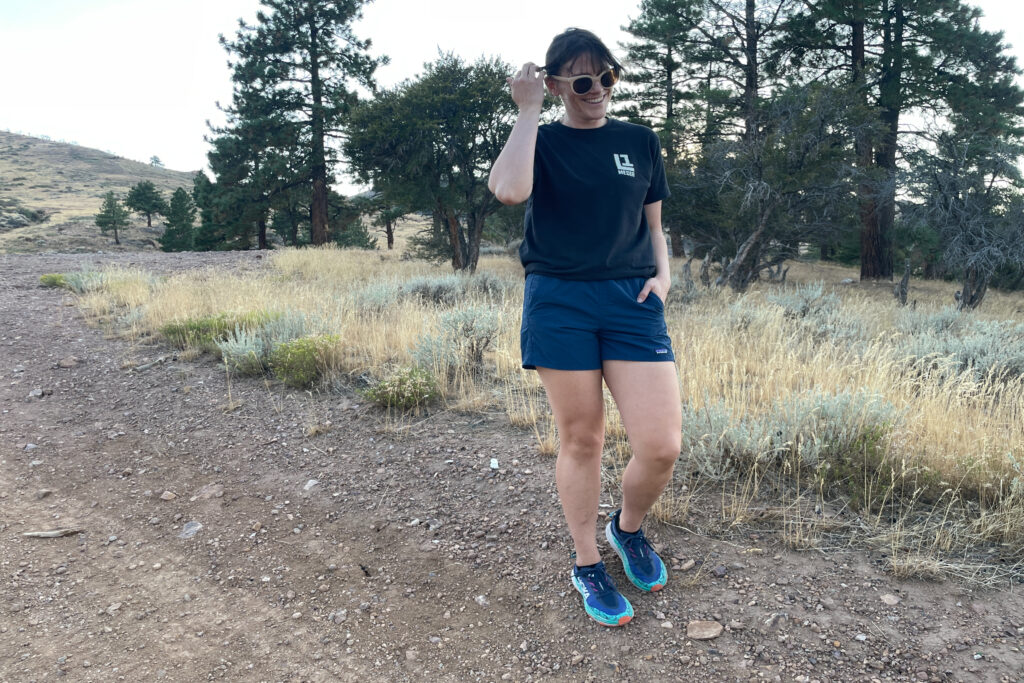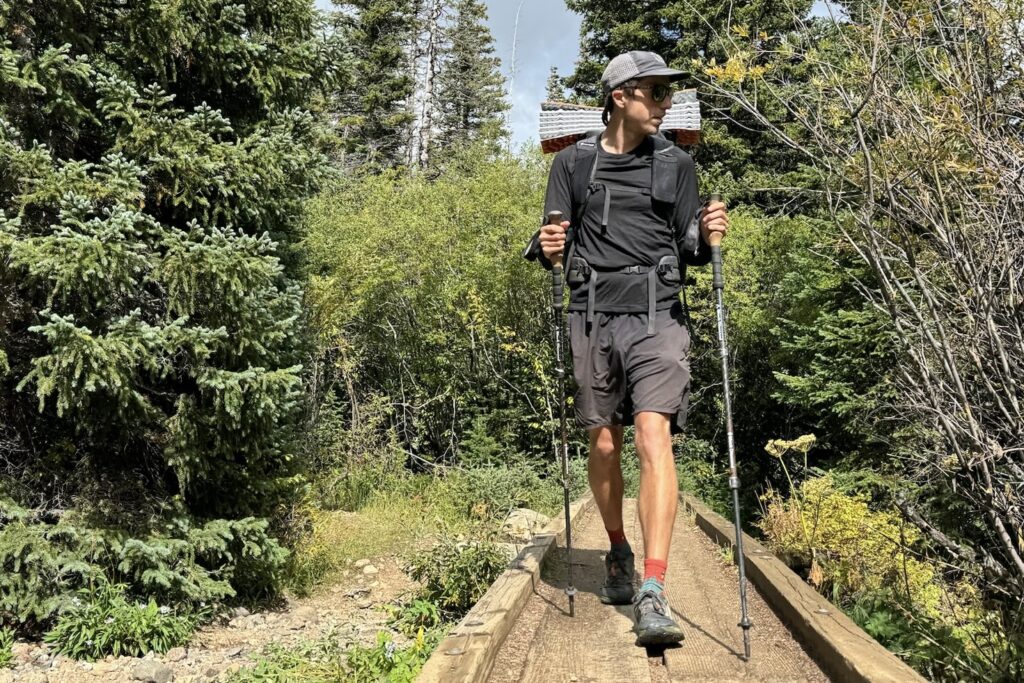
Bottom Line
The Sea to Summit Ether Light XT Insulated is one of the more comfortable and easy-to-set-up backpacking sleeping pads we’ve tested. CleverHiker Gear Analyst Heather Eldridge enjoyed its top-tier comfort while hiking 5 days along the Rogue River, and CleverHiker founder Dave Collins appreciated its fast inflation and deflation on a 60-mile trip in the Steens of eastern Oregon.
Featuring a quilted pattern for superb support, cushy “air sprung cells” with 4 inches of thickness, and inclusive sizing that caters to all body shapes and sleeping styles (rectangular and women’s versions as well), the XT Insulated makes nights in the backcountry feel a bit more like sleeping on your bed at home. The 40D fabric and attention to detail add solid durability, and it’s plenty warm enough for three-season treks in fair temperatures.
That said, the XT Insulated does have a few downsides. For this level of comfort and durability, you’ll sacrifice some weight. At 1 lb 1.3 oz, this pad ranks among the heavier and bulkier pads CleverHiker reviewed. For this reason, it will miss the mark for ultralight and minimalist backpackers looking to save every ounce they can.
Additionally, the surface has a slightly rubbery feel and sound that might be a dealbreaker for light or sensitive sleepers. And the XT Insulated isn’t the most affordable, nor is it the warmest pad. But this is a solid choice if you’re a summer backpacker who wants a seriously comfy pad with a long-lasting design.
Quick Specs

Sea to Summit Ether Light XT Insulated
Price: $199
Weight: 1 lb. 1.3 oz.
R-Value: 3.2
Thickness: 4 in.
Pros
- Lightweight
- Above-average comfort
- Exceptionally durable
- Cushy
- Quick inflation/deflation
- Pump sack included
Cons
- Expensive
- Heavier/bulkier than some
- Slightly rubbery feel/sound

Comfort
For comfort, the Ether Light XT Insulated earns high marks. This pad is a luxurious 4 inches thick! That’s a half-inch thicker than any other backpacking pad we tested. Not only does the XT Insulated block out the cold ground, but you won’t bottom out during the night – even if you’re a side sleeper. Senior Gear Analyst Ian Krammer sleeps on his side and stomach and finds this depth is plenty for rough terrain. It effectively gobbles up lumps, bumps, and low points wherever you set up, so you’ll only notice the smooth surface as you nod off. The “air-sprung cells” mimic the feel of a pocket-spring mattress, creating a supportive quilted surface.
The XT Insulated has slight side rails that cradle the body, prevent uncomfortable pressure points, and keep you centered as you sleep. The single-valve system has a fine-tune button to perfect your firmness with minimal effort. We’re also big fans of Sea To Summit’s PillowLock system – hook-and-loop patches on top of the pad that keep your pillow in place where it should be – right under your head. This pad comes in many inclusive sizes, too, so there’s a comfy version for all body types and needs, including sizes small to large and a women’s specific model.
We do have a couple of small gripes, though. The 30D nylon fabric on top isn’t a great fit for everyone – it has a somewhat rubbery and slippery feel that takes some getting used to. During testing, we found that the fabric has a tendency to crinkle and squeak slightly as you shift positions, which could be an issue for light sleepers.
Additionally, the plasticky surface can feel a bit clammy against bare skin on warm nights. The XT Insulated is super cushy and thick, but that also means it’s a tad heavy. Due to its burly build and the sheer amount of material it uses, this pad is heavy for backcountry miles, so we recommend it for added luxury on shorter trips. Finally, this pad is not the warmest out there – the 3.2 R-value makes it a good choice for late spring to early fall, but it’s not the most versatile the rest of the year.

Weight & Packability
The Sea to Summit Ether Light XT Insulated might be one of the thicker pads we’ve tested, but it’s still a solid choice for backpacking. At 17.3 ounces (not including the pump sack), it’s not ultralight, but that’s a reasonable weight for hikers willing to carry a bit more weight for added sleeping comfort.
The pump sack adds 2 ounces to the overall weight, but it doubles as the roomy stuff sack for the pad, making it worth the small amount of extra weight. And despite its 4-inch depth, average insulation, and thick nylon fabric, XT Insulated still packs down quickly and easily. A two-in-one dump valve allows you to release all the air in seconds, and the XT Insulated rolls into a 4.5 by 9.5-inch package that fits well into backpacking packs.
One of our biggest complaints with the Ether Light XT is that it’s heavier and bulkier than many competing sleeping pads. It weighs 19.3 ounces with the pump sack included, putting it on the same scale as more insulated and warmer pads – but without their generous warmth. This tradeoff is acceptable if your top priority is comfort, but it falls short for cold conditions and long-distance trips where every ounce counts.

Warmth
With an R-value of 3.2, the Sea to Summit Ether Light XT Insulated is a good choice for summer trips and will keep you warm down to around 40°F, depending on the sleeping bag you pair it with. Sea to Summit utilizes Thermolite in the interior of this model – a synthetic insulation made from polyester fibers – that retains body heat and blocks out the chill.
The “air sprung cells,” side rails, and quilted pattern further help trap warmth around the body by distributing pressure evenly and reducing cold spots. The pump sack also adds to the warmth of this pad – pump sacks minimize moisture buildup inside the pad from your breath, which can eventually affect its performance in colder temperatures.
The Ether Light XT Insulated doesn’t quite live up to its name. This model has more than twice the R-value of the lighter Sea to Summit Ether Light XT Air, but it falls short compared to other pads in the backpacking category. The lower R-value means this pad feels chilly below 40°F, so you’ll want to keep this one exclusively for summer and milder shoulder season conditions.
And even though it’s not as warm as we’d like, this pad is still on the heavy side, which is not a great quality for backpacking gear. Finally, the slightly rubbery surface is not our favorite on warm and hot nights, when it tends to feel sticky and a bit uncomfortable on direct skin.
All that said, when paired with a quality sleeping bag, this pad is still a great fit for most summer adventures. If you know you’ll be in colder temperatures, consider their much warmer 4-season version with a 6.2 R-value.

Ease of Setup
The Ether Light XT Insulated is fairly easy to set up thanks to simple and efficient components. The pad’s thicker fabric, with 40D nylon on the bottom and 30D on top, unfolds easily, and it doesn’t take long to inflate the full 4-inch depth.
When backpacking, we prefer gear that serves several purposes – and in this model, the stuff sack doubles as a pump sack. As a storage sack, it’s roomy and easy to get the pad in and out, so you won’t be wrestling with it. As a pump sack, it snaps on securely to the single valve, and the wide opening only takes three or four rounds to fill the pad.
The Ether Lights’ one-way valve system allows for efficient inflation, and micro adjustments are a breeze – just press a small center button on the valve to let out a tiny bit of air at a time and fine-tune the firmness to your liking.
What are the downsides? Like most pads, the pump/storage sack is an excellent addition, but it adds a bit of bulk and 2 ounces of weight to your kit, which might be an issue since this pad is already a bit on the heavy side. The XT Insulated is easy to set up, but it’s still heavier and cumbersome compared to ultralight options.
Finally, the valve’s placement isn’t for everyone. Located on the top corner of the pad, it’s convenient for inflation and deflation, but it can be a hassle for sensitive and active sleepers who might brush against the cap at night.

Durability
The Ether Litght XT earns above-average scores for durability. This sleeping pad has a robust 40D ripstop nylon fabric on the bottom, which is thicker and tougher than what’s found on most backpacking sleeping pads. It uses 30D fabric on top, making the pad impressively resistant to punctures and tears. During testing, our dogs unintentionally crossed this pad multiple times, and we never had to worry about their nails puncturing the pad.
TPU lamination adds stability to the seams to prevent seepage along the sides of the pad, and we like the single valve opening with simple components since fewer parts can fail. Sea to Summit includes a repair kit with six self-adhesive patches and a spare valve insert in case of damage, but we’ve yet to need ours after several dozen nights of use.
The Ether Light XT is strong, but it has limitations. The nylon fabric is stronger than many competitors, but it still won’t stand up to serious mishandling, so you’ll need to be mindful of sharp rocks, rogue sticks, and debris in your campsite. That said, the XT Insulated needs minimal maintenance and will last hundreds of nights in the backcountry if treated with a little care.

Should You Buy the Sea to Summit Ether Light XT Insulated Sleeping Pad?
If you don’t mind backpacking with a bit more weight for top-of-the-line comfort, the Sea to Summit Ether Light XT Insulated is worth considering. Its supportive 4-inch thickness and soft air-sprung cells offer a plush sleeping surface that feels more comfortable than most competitive pads. The Ether Light is warm enough for summer backpacking trips, and it’s suitable for mild spring and fall trips as well.
The smart pump/inflation sack makes this pad easy to inflate and pack away, and its dump valve makes packing up quick. The price of the Ether Light is on the high end, but it is a high-quality product with solid durability.
We still need to mention where this pad misses the mark in a few key areas. Even without its pump sack, the Ether Light XT is a bit heavier and bulkier than most of its competitors in this price range. And the same is true for its warmth. The Ether Light has a lower R-value than most of the leading backpacking sleeping pads in this price range.
This model also has a slightly rubbery texture and sound when moving at night that may not suit light sleepers or those sensitive to noise. But for those willing to pay a little more and carry a little more, the Ether Light XT Insulated does offer a seriously comfortable night under the stars.

What Other Sleeping Pads Should You Consider?
NEMO Tensor All-Season Review: The NEMO Tensor All-Season is one of the most balanced backpacking sleeping pads. It costs about the same as the Ether Light XT Insulated, but it’s much warmer and weighs quite a bit less. The Tensor is also very comfortable, easy to use, and durable. This pad is among our favorite choices for backpacking sleeping pads.
Therm-a-Rest NeoAir XLite NXT Review: The NeoAir XLite NXT is another sleeping pad at the top of the list for comfort and quality. For around the same price as the Ether Light XT Insulated, the XLite is also much warmer and lighter. In fact, the XLite NXT is one of the lightest insulated sleeping pads on the market, making it a great choice for hiking long miles. A few minor details knock the XLite NXT down a notch for ease of use, but it’s clearly among the best backpacking sleeping pad options out there.
Sea to Summit Ultralight Insulated Review: This other Sea to Summit model shares many of our favorite traits with the XT Insulated, but it weighs less and is more affordable. It’s also easy to set up and has about the same R-value, but it’s not as thick, so you may bottom out when shifting around. This pad is a good option for backpackers who still want comfort and weight savings, but it comes at a more budget-friendly price.
NEMO Tensor Trail Ultralight Review: The NEMO Tensor Trail Ultralight has benefits similar to those of the Tenor All-Seaon listed above, but it’s a bit more affordable and lighter. The downside is that it isn’t nearly as warm as the All-Season, so it’s a better choice for summer backpacking and mild shoulder season weather.
























